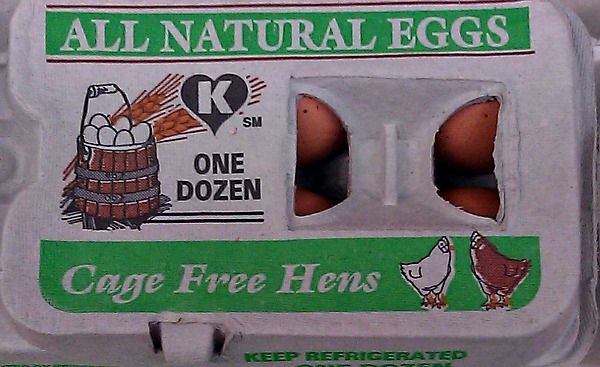 Meat and eggs labeled as “free range” or “cage free” have become increasingly popular in recent years as consumers try to source higher quality food for their families as well as to vote with their food dollars for humane and “green” conditions for the chickens themselves.
Meat and eggs labeled as “free range” or “cage free” have become increasingly popular in recent years as consumers try to source higher quality food for their families as well as to vote with their food dollars for humane and “green” conditions for the chickens themselves.
When most people think of free range, cage free chickens, they get a picture in their mind of happy chickens outdoors in the open air, completely free to express their chicken-ness by clucking around and pecking in the dirt for grubs and insects.
The truth of the matter is something else entirely. In fact, one of the more popular posts on the Healthy Home Economist Facebook page recently was a picture of the actual living conditions of free range, cage free chickens.
After seeing this Facebook post, Susan O. a reader who rescues “free range” chickens from commercial operations, sent me a series of shocking photos. Here are the photos along with her description of what these poor chickens endured, which turns out to be not much better than regular battery hens in cages.
Susan’s own words describing the 3 rescued “free range” hens – at only 1 year old:
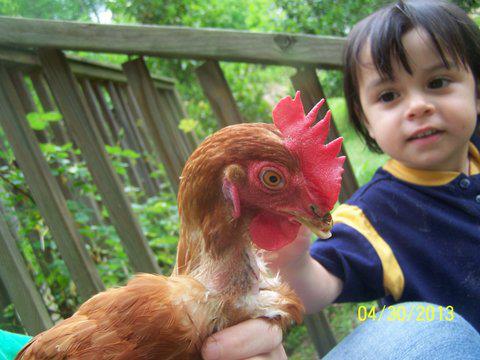
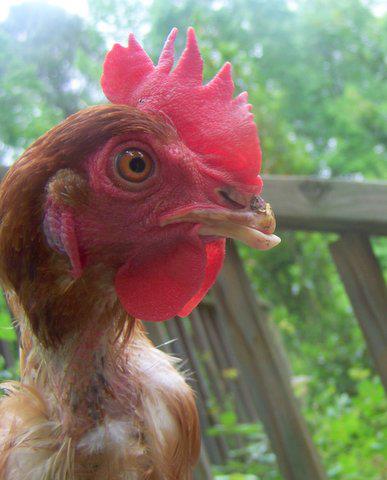
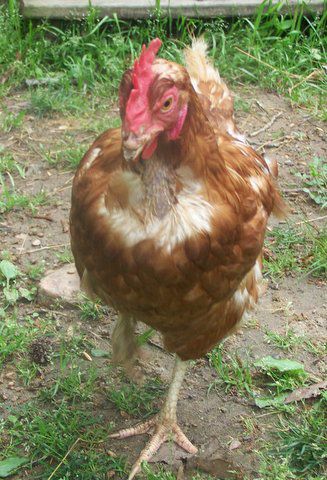
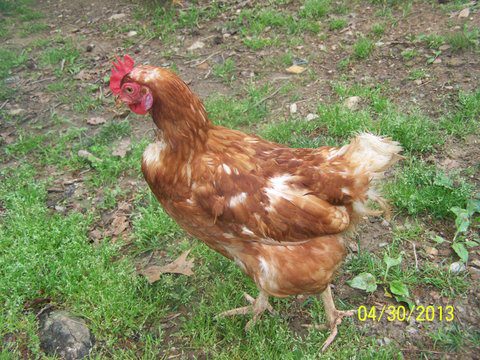
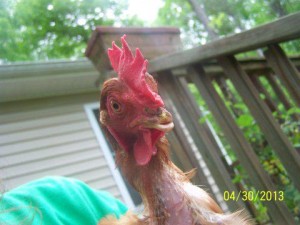
We “rescued” 3 hens from a commercial supplier who had one year old spent hens they wanted to sell. Their breed is Isa Brown.
The eggs were sold as “free-range” and “cage-free”.
We had no direct contact with the main supplier. It was very difficult to get the hens. Another person who purchases mass amounts of the hens from the egg supplier for $1.00 each was tracked down and he agreed to sell them to a group of rescuers for $10.00 each.
We’ve had these hens for a little over a month and they look much better then they used to. These photos were taken last week. When they arrived they were in much worse shape.
They’d never been outside, had no idea how to act like chickens. They wouldn’t roost at night, just pecked and walked around all night long.
I suspect their “house” was kept lit almost 24 hours a day for greater egg production. They pecked EVERYTHING. Trees, plastic, metal.
They were clueless. I had to cut their toenails. They were over an inch long!
One was limping her toenails were so long. They all had hen mites. All have feather loss. The combs on their heads were not the color they are now, but very pale, a sign of anemia and malnourishment.
The red fleshy part near the ear area was white and is still a little white today. Their eggs were without shells, had only a membrane on the outside from extreme calcium deficiency.
Another rescuer said her hen laid an egg and it broke inside her. They’ve also had their beaks cut. These hens will need to be on a special diet. They can’t crack corn or seeds with their beaks or pick up regular feed that’s not crumbled.
It’s like removing a human’s four front teeth and telling them to eat. They’ve learned to become very efficient at grabbing worms out of our compost bin. They are very gentle animals. We can pick all of them up and pet them.
People need to understand that the meat industry sees an animal as simply a product, to be used until they’re spent, then discarded like trash. The last thing the industry is worried about is our health and providing us with nutritious food.
We have a small homestead and do raise chickens and rabbits for meat, but these rescued ladies have a “free pass” to enjoy being chickens for as long as they live.
When friends shake their head and say “I couldn’t do it ” when I tell them about raising animals for meat, I draw the comparison between my healthy hens and these poor rescue hens.
If these “cage-free” hens were in this bad of shape at only one year old, I shiver to think how bad a typical battery hen would be. And no doubt, the gentleman gave us the better looking hens. Not everyone can afford pastured meat (but we manage, even on a budget 200% of the federal poverty guidelines and without taking any government assistance ), but pastured eggs can be afforded by most.
What Does a Healthy Chicken Actually Look Like?
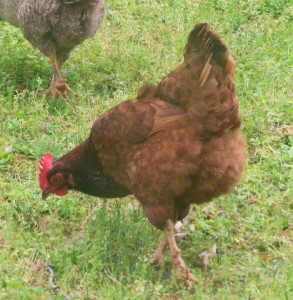 This is a photo of one of Susan’s long-time yard hens. She’s a comparable breed to the Isa Brown. She’s been truly free range since the day she was born.
This is a photo of one of Susan’s long-time yard hens. She’s a comparable breed to the Isa Brown. She’s been truly free range since the day she was born.
Note the tremendous difference between the two, “cage free” store label hen vs truly free range hen. No missing beak, feathers, white spots or mite infestation. The happy chicken is focused on the ground, pecking for insects and grubs instead of the pathetic, sad, vacant stare that signifies the horrifying animal abuse endured by chickens whose meat and eggs are labeled “free range” at the store.
In order not to be fooled into thinking your chicken and eggs come from happy birds like this one to the right when they actually come from beakless, anemic, mite ridden animals that have been so abused they can’t even peck in the dirt or crack corn, resolve to buy local!
When you buy from a neighbor or small scale local farmer who raises chickens, you can see them for yourself and note their health by the living conditions.
Abdicating responsibility for knowing exactly where your food comes from by trusting meaningless food labels in a store that proclaim eggs or meat as “free range” or “cage free” is not helping to secure quality food for your family nor is it helping to promote the cause of humane conditions for farm animals.
Sarah, The Healthy Home Economist







I just started keeping backyard chickens and it’s really not that hard. Now I know exactly where my eggs come from and exactly what they’re eating. Between them, the compost and the worm bin, we have practically no waste and the eggs are just wonderful.
Sarah, this is off topic, but are you going to have any more posts from Konstantin? I haven’t seen anything for a few weeks. I always look forward to his guest post on your site.
Love this post about “cage free” hens. This is why my family will always buy eggs from our local farmers! In fact, my son immediately notices if I have to occasionally supplement with “free range” eggs from our local health food store. He can tell the difference in the flavor and the color!
We used to buy bulk organic eggs from Costco, and recently stopped because we wanted to buy local and super fresh. QUESTION: If the carton or label says organic, are you safe? Or are there misconceptions with the raising and quality of those eggs too?
Organic eggs are only organic, NOT pastures, NOT heritage, NOT having any standards of treatment. A mere “organic” egg could be from the exact same farm that works for Monstanto with the exact same setup only in one 100,000-chicken barn they are given regular GMO corn and soy and in the other barn they are given organic corn and organic soy.
I’m resolved now more than ever to buy local eggs. I just found a great source at a local market: totally free range, no feed at all, the eggs aren’t even washed!! I love this – and as a great bonus, they are very affordable. Most of the eggs at the market are not totally free range and they are prohibitively expensive.
OMG, that is so awful and so sad. Chickens are the greatest creatures once you raise a few and find that out. So good of you to take a few of them into your flock. I know I would if I could. I have never seen a chicken with it’s beak cut off. I thought that was a birth defect when I first saw it.
When my chickens were not laying, I had to buy some eggs and there is a huge difference in the color of the yolks, esp in the eggs that are called organic. My yolks are orange-colored compared to the pale yellow egg yolks in the stores, yet I could not sell my eggs as organic. My chickens are loved and outside all day.
We have chickens in our back yard and usually have eggs, but from time to time we’ve had to buy eggs due to natural cycles our hens go through. Whenever I buy I make sure the package DOES NOT say vegetarian diet….chickens are not vegetarians!! They are omnivores/scavengers. They will eat just about anything (grass, bugs, frogs, snakes) and if a chicken is supposedly free range there’s no way you can guarantee vegetarian–that could only be a cooped, controlled chicken.
And buying local doesn’t have to be farmer’s markets. Ask at your local feed shop–they usually supply chicken feed and sometimes have community bulletin boards advertising things like this or know who’s selling eggs. I’d rather have a true free range chicken fed commercial feed as a supplement than an “organically fed” chicken who’s cooped up all day.
Just my 2 cents.
I agree that buying local doesn’t have to be farmers’ markets and there are some other good options. You still need to talk to the farmer in any case to find out the farming and feeding practices.
As a reminder, a great way to find out about local family farms that do things the way that is being discussed here (not all do, by the way), is to contact your local Weston Price chapter leader. It’s their job to know this information and connect farmers and consumers. Go to http://www.westonaprice.org/local-chapters/find-local-chapter
As a member of the agricultural industry your claim that, “People need to understand that the meat industry sees an animal as simply a product, to be used until they’re spent, then discarded like trash. The last thing the industry is worried about is our health and providing us with nutritious food.” concerns me quite a bit.
I understand that you are concerned about chickens being treated well and I agree that animals shouldn’t get to the point of malnourishment. But I think its comments like this that give agriculture and farmers a bad reputation. According to the 2007 Census of Agriculture, the vast majority of farms in this country (87%) are family farms.
These farmers don’t just see animals simply as a product and then discard them like trash. Are they used for meat products? Yes. But if they didn’t care for their animals and keep them healthy, they wouldn’t end up with a healthy or nutritious product, which in turn, won’t get sold to distributors.
Also, I would like to clarify that I’m not saying there aren’t a few instances where improper care happens, but the whole industry shouldn’t get a bad label slapped on them just because of a few bad eggs (no pun intended).
The farming industry IS concerned with bringing healthy nutritious products to market because they eat those products too. They wouldn’t want their family eating unhealthy food just as much as you or anyone else.
I appreciate you writing about your topics of concern, I just wanted to send a suggestion to keep in mind that one single statement like this can have a larger affect than originally intended and can cause people who don’t have much connection with farmers, to have bad views of the honest, hard working farmers that this country was built on and still exist today.
I think with meat that would be the case. With egg laying chickens, that is where the mistreatment issue comes in and dairy cows also. Meat cattle are outside all day eating grass, which makes me wonder why everyone claims grass-fed beef is better when all cattle are grass-fed. At the end they bring the cattle in to grain feed, right before taking them to auction, to fatten them up.
Although I cringe every time I see a semi-load of chickens being carried to the slaughterhouse.
Cheryl, they are grassfed until about 4 months before slaughter, at which point they are pumped full of hormones, antibiotics and fed GMO grain that makes them sick and fat. Grassfed beef, on the other hand (100% grassfed) is ALWAYS on grass and they are not treated with hormones and antibiotics (in almost all cases).
Cheryl, true grass-fed beef are on a grass feeding program the whole time. Traditional beef cattle are the ones that eat grain in the finishing stage. This helps create the marbling in the meat that people look for.
Just wanted to say that traditional beef that are “finished” off on grain is not for the marbling in the meat, it is for gaining weight. My husband who used to raise a lot of cattle will tell you that the ‘feed lot’ where the cows are finished off is solely for putting more weight on the cow before it goes to slaughter… it has nothing to do with better beef… sad but true.
Most readers here love and support family farms. We buy directly from them and through this connection we can find real family farms.
I suspect your definition of a “family farm” is actually more of a subsidiary to a large company. Can the family farms you describe sell directly to the public or are they under contract to sell to a big company? Are these so called family farms small scale or do they raise thousands of animals? Do they even know what is in the feed they are provided? Do they own the animals? In the case of chickens in particular, calling this system a family farm is a lie. The families go into huge debt and are practically enslaved by their contracts to the parent company and their land is ruined. I will never support this system for many reasons and I encourage everyone I know to buy eggs and chickens from small scale farms they can visit themselves. Many people I know (myself included) now keep their own layers and meat birds.
The meat industry sees the animals – and the small farmers that work for them – as a product that can be discarded like trash.
Chelsea, I appreciate that some of the farmers do treat their animals better than others, It would be good if you could send some pictures of your operations so that we could see how well they are treated, housed, fed , etc. I am afraid though that the vast majority of the animals are not treated in a manner that would be acceptable to many of us consumers. The agribusiness that buys your products won’t let you raise them humanely. Seeing is believing and I have seen battery hens.
Brian, thank you for your comment. While I grew up on a farm and around livestock, I don’t currently farm. I do still work in agriculture, but don’t manage animals daily. I do however, visit farms often and studies animal agriculture in college and know that there are a lot of Indiana farmers that are happy to share and talk about their operations. And some are even open to visitors, as long as careful measures are taken not to bring in disease or bacteria. Here is a website that highlights several Indiana Farmers if you’d like to learn more about them. http://www.indianafamilyoffarmers.com/consumer.html
A good place to go if you’d like to learn more as well and chat with some farmers and ranchers would be to participate in #agchat on Twitter. http://agchat.org/agchat-foodchat
I hope these help! Please let me know if you have any other questions and I can try to help answer them or get you in contact with a farmer who can answer them!
You can smell them before you see them . . .
Chelsea N. :
My statement is directed at factory farms who take an animal out of it’s natural environment and contain in a small, artificial area and feed it substandard feed. An example would be factor feedlot, etc. It would be difficult for someone to convince that a calf standing in a 4′ box in its own waste would be anything other than treating an animal as a product.
When I used the word “industry”, I was directing it at large corporations that do the above, certainly not family farms. We do raise our own meat : rabbits and chickens. We don’t have room for larger livestock, but we buy those live from local farmers and process together at my friend’s farm. I’m definitely not against the consumption of meat or family farms, or even larger ones where animals are kept in a natural, pastured environment.
I appreciate you pointing out my statement and certainly understand so how it could be misunderstood. I hope my clarification helps.
Susan
There is a difference between an honest hard working mega farmer and an honest hard working farmer who in hands on rather than behind a desk. Less than 2% of people farm in the US. Most are mega farms that have scaled to survive over the last several decades just to survive in the world of cheap main stream food. And while they may care about there animals, they care more about there animals productivity and use that as a gauge for determining animal welfare.
Also do not assume that safe wholesome food means high animal welfare. The nutritional integrity of an egg as a food is a different than assessing that birds quality of life while laying that egg. Birds on pasture like Vital Farms do produce a distinctly different egg both on appearance and taste when consuming bugs and grasses. Not all eggs will look the same depending on the season and what available to the bird.
Question; Is a USDA Certified Organic egg produced in a cage (which is not allowed) different from a USDA Certified Organic egg produced in a cage free setting with meaningless outdoor access? ( as is the current standard)
Answer; From the stand point of food integrity and nutritional value NO. But most all people associate animal welfare into there buying decision of items like milk and eggs and trust the USDA organic shield which has been trumped by many farmers and brands like Vital Farms who provide meaningful welfare and get paid to do it the right way.
While 86% of America’s farms may be “family farms”, most of the “food” produced in the U.S. is not healthy or nutritious. We have millions of acres of corn, soy, wheat, etc. and a lot of CAFO’s. I wouldn’t consider a farm quite a family farm if the family running it are just sell outs to Monsanto. It is the small family farms that sell locally that have real integrity. If farmers are concerned about their image (as I know many of them are), then they need to have a more personal relationship with their consumers like Joel Salatin does. I highly recommend you check out his books. Anyone frequenting Sarah’s blog is not going to think that farmers are some heartless group of people. Rather the opposite. We want a relationship with our food and the people who produce it. Just today my husband and I had the hardest time finding some things at the grocery store (we were buying stuff for a friend) because we source much of our food locally directly from the farmer & have become unfamiliar with the set up of the grocery store. Some farmers have a bad attitude about the consumer. They see us as merely fickle people that don’t have a clue about things. Joel Salatin talks about this in his book “You Can Farm”. I’m sure he discusses it in all of his books. While I don’t blame it entirely on the farmers, they certainly had a part in the modern food movement that separated farmers from their end consumers. This divide is what has created so many problems for both farmers and consumers and left all the benefits for the few massive companies that now control most all of our food from seed to package. There are farmers that are trying to raise heritage breeds, grow heirlooms and sell them to local people. They are constantly attacked by government agencies (who are really just pimps for the big ag companies) & it is truly a disgraceful warfare. More farmers need to join the fight & more consumers need to demand that the farmers who produce quality food are allowed to do so without the government meddling. I don’t need my farmer to be regulated by anyone. I visit his farm every week. I see how the animals are raised & I even have the opportunity to see how he processes all his poultry. His customers regulate him. The government is just wasteful bureaucracy. Anyway, I really hope you will check out Joel Salatin’s stuff. I think that being part of the ag industry, you’ll appreciate it. He’s actually pretty funny too. Best wishes.
This is so sad. I am obviously clueless. I thought that buying free range pastured chicken eggs, Vital Farms brand, would be healthy and happy free chickens.
I want to buy local but here The farmers market is open beginning in May.
The industry goes to great lengths to hide this from consumers. You can’t hide it if you are a local farmer … the customers see it for themselves.
Actually Vital Farms scores quite high on Cornucopia’s egg producers’ score card
Local is still better, but if you can’t get eggs from a local farmer this would be an excellent option.
I went to Whole Foods today (Whole paycheck?) with the intention of buying Vital Farms eggs. They were $7.39 for a dozen!!!!!!
From my understand, Vital Farms chickens are ON PASTURE, not “cage free”. I do not think they are raised strictly in barns, but actually eat a natural diet, out on pasture.
Yes, this is the critical distinction to make with any egg producer or chicken producer:
make sure they are actually outside on green pasture, getting sunshine and eating grubs and bugs which greatly increases the nutrients and honors the chickenness of the animal.
There are other criteria to ask about, such as soy-free, GMO-free feed and no antibiotics or added hormones. But whether they are actually outside on pasture (not indoors with “access” through a small unused door, and not confined outside on a small patch of bare dirt) is #1 on my checklist.
The BEST is outside on green pastures following cattle in a rotational grazing system. Then they get the added benefit of getting nutrient dense grubs from the cow pies and breaking them up so they can replenish the soil. A complete eco-system!
Vegetarian Fed is another bogus and detrimental marketing claim since chickens are omnivores and do best eating bugs and grubs in addition to fresh, non-GMO plant foods grown without chemicals and pesticides.
I think the point they are making with the whole “vegetarian diet” thing is that the chickens weren’t fed ground up “meat products” as part of their feed. They are just making the point in a “lets not gross out the potential buyer of our product” way.
One of my favorite memories is of my husband cutting up the lower moose legs with an ax into sections for the dogs to enjoy, and pieces of meat and bones were flying everywhere, and the chickens came running over and had the best time picking up all those pieces. They also came and hung out any time we were cleaning fish. Chickens definitely enjoy a bit of meat in their diet, besides bugs that is. 🙂
Sounds like someone has been reading Salatin! I hope to is visit his farm this summer.
Yes, the other posters are right. Vital Farms is an excellent store-bought option, the ONLY pastured brand at Whole Foods. Local eggs are plentiful where I live but I’m so grateful they are available when I need eggs in a pinch if I’m out of local eggs. They taste amazing, have deep orange yolks and really hard shells: all the benchmarks of a good egg!
Vital Farms is happy and healthy chickens. The Cornucopia Institute’s egg report shows them to be the best brand in Illinois, and Vital Farms eggs are PASTURED not “free range”. Please keep buying Vital Farms Organic eggs!
Nauseating to read this – but so important to know!
There is a wealth of information about eggs here: (be sure to click through to all of the pages dealing with eggs – and there’s lots more . . .)
Thanks for keeping these kinds of issues in our collective face – hopefully someday our food will be safe to eat!
Yes. I ran a commercial chicken house for many years. With 27,000 hens and cockerals. They did a wonderful job of producing eggs…and they actually had it pretty good as far a the industry goes. Compared to some. But free range absolutely not.